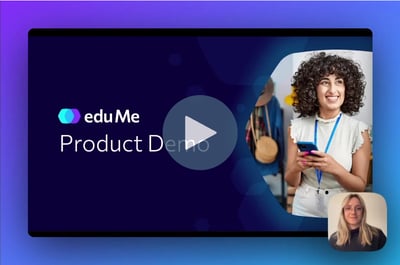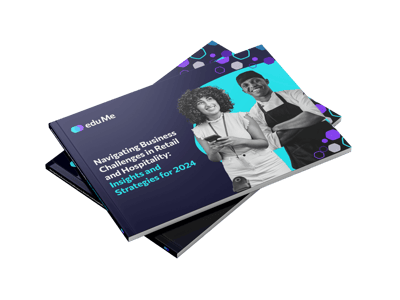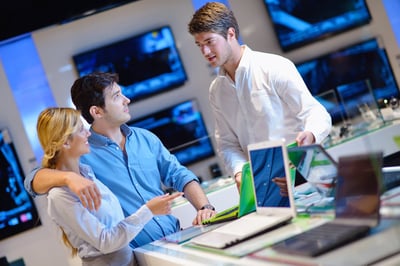When retailers want to increase their revenue, they may look to effective marketing to expand their customer base and recruit new prospects.
However, many fail to take advantage of their most profitable source of income—their existing customers.
Recruiting new consumers is a process that’s five times more expensive than keeping a current one. On top of this, your existing customers spend, on average, 67% more than new ones. All signs point to getting the most out of those already loyal to your business, and optimizing your upselling approach is the best way to do it.
Keep reading to find out what upselling in retail is, why it’s important, and how to optimize upselling for the benefit of your store.
What is Upselling in Retail and Why is it Important?
Upselling is a sales technique that aims to convince potential buyers to purchase either a more expensive, upgraded version of the item they were initially intending to buy, or product-related add-ons. Upselling in retail is exactly that but in a retail setting. For example, you visit an electronics store intent on purchasing a 32-inch TV, and instead, you leave with a 40-inch TV and an accompanying sound system. Upsell successful.
It’s no secret that convincing your customers to buy more increases your bottom line, and upselling can increase revenue by 10-30%. Though it seems obvious, many retailers look to retain customers and nothing more, failing to see that the job isn’t done—your customers' value can increase via effective upselling.
The benefits of upselling extend beyond the financial. It fosters motivation by creating friendly competition amongst your staff and fueling their desire to win. And your newly motivated employees are now 87% less likely to leave their job, meaning upselling can increase revenue and improve employee retention and motivation.
Less obvious, but just as important, is that the customer also benefits. The mention of sales can often conjure up the image of a greasy salesman trying to swindle the customer into purchasing a useless product at an extortionate price. In reality, upselling is a mutually beneficial process. Its true purpose is to present all available options to the consumer so they can make a more informed decision. Sure, you’ve helped them leave with a more expensive item, but it’s also more durable and of greater quality. Customers who believe a business has their best interest in mind have a more satisfying experience.

How to Optimize Retail Upselling
Now that you’re aware of the benefits of upselling, it’s time to optimize the process. Below are some methods you can adopt to optimize your workforce and help your store thrive.
Teach Sales Techniques
Start with the basics. Upselling requires learning a plethora of sales techniques that can be applied to the variety of customers who visit your store daily. What works for one might not work for another. Some consumers are more receptive; others will seriously test your knowledge of the products before making a decision.
Roleplay is a flexible way of preparing for almost anything. It simulates real-life situations and can provide the closest thing to a script for your staff to reference. Prepare your workers from day one by incorporating sales techniques into your onboarding and reinforcing behaviors with continuous learning. Training is an ongoing process and techniques should evolve alongside your store.
Focus on Product Knowledge
Although sales techniques are important, they’re made redundant if not paired with knowledge of the products. You can’t sell something you know nothing about, no matter how good you are. Ensure your staff are put in a position to succeed early on by providing them with in-depth knowledge of the products you’re selling. Considering that 83% of consumers believe they know more than store associates, having a knowledgeable staff can really separate you from the pack.
Your approach should mirror that of sales techniques—provide your workforce with product information during onboarding and continually update them throughout their time with you. This is especially poignant for retailers who are constantly changing their products and who want to push certain items.
Apple is an example of a company that emphasizes the importance of product knowledge. Their products are always evolving, and they require their ‘Geniuses’ to know everything about the latest gadget and how to effectively talk about them to your average consumer who is likely not as tech-savvy. This is achieved via effective and continuous training, resulting in an improving retail arm that ranks highly on the customer satisfaction scoreboard.
Set Goals
You’ve provided sales training and product knowledge, successfully putting your staff in a position to succeed. It might seem like your job is done—it isn’t.
To get the most from your workforce you need to motivate them. Setting goals is a great way to foster intrinsic motivation and appeal to our desire to better ourselves. By giving your staff something to aim for, you’re encouraging them to put their training into practice.
Furthermore, goals are stepping stones to an end result and make a retailer's target look more achievable. If your target is to increase your annual revenue by $500,000, that could appear daunting to staff members who are just seeing a big number. But breaking it down on an individual level—meaning each employee’s goal is $2000 in monthly total sales—creates, in their eyes, a realistic target that increases motivation.
Add Incentives
While intrinsic motivation can prove useful, some of your team may find extrinsic motivation more effective.
Incentives are a great way to motivate your staff to implement their training and they can take the form of monetary rewards, shift preferences, and additional benefits. In this case, the more abstract, unpredictable elements of motivation such as personal fulfillment and enjoyment aren’t significant factors.
We recommend combining gamification with incentives to really enhance your staff’s desire to upsell. Consider creating a leaderboard of who makes the most sales, with the winner receiving prizes.
Enhance your In-Store Displays
Aid your staff’s upselling by optimizing your in-store displays. Visual stimuli are incredibly persuasive, hence why it’s often the focal point of advertising campaigns. Putting the products you want to push in front of your customers can go a long way toward turning them into purchases.
Present upsell items at the front of the store to immediately catch the eye of customers. Your consumers' attention is something worth competing for, so if the desired items are the first thing they see then you’ve put your products in a position to succeed.
Follow the rule of three. Studies show that our brains respond to items grouped in threes due to their asymmetry causing our eyes to move around. Use this to increase sales by grouping three similar items together in-store. For example, grouping the iPhone 12,13, and 14 together will draw the customer in, and then your staff member can upsell the latest model.
Optimizing in-store displays often requires an understanding of the psychological processes that define human behavior. Point-of-purchase displays are another effective sales aid that capitalizes on our propensity for impulse buys. The more you understand a consumer's mind, the easier time you’ll have making sales.
Utilize Promotions and Bundles
It’s not just your workforce that needs incentivizing, your customers do too. Offering promotions and bundles is an incredibly effective way to drive sales and increase ATV.
89% of customers stated that price is the primary factor influencing their purchasing decisions, demonstrating the importance of providing a bargain in the eyes of your consumers. And by offering discounts and bundles, you ease the burden on your staff when upselling.
There are many ways to optimize your promotions, such as temporary price drops that create urgency, or the classic buy-one-get-one-free promotion. These should work in tandem with your in-store displays—make people aware of your offers through effective product placement.
And consider introducing a loyalty scheme. Prominent retailers are already reaping the benefits of loyalty programs, helping them sell more and retain customers. Starbucks offers a rewards-based system that lets you earn stars to unlock rewards such as a free drink. Work out what your business can offer your customers and reward them for their commitment.
Leverage Technology
Your retail workforce provides a unique training challenge as they’re constantly on the move and working a variety of shift patterns. Traditional classroom training will therefore prove logistically difficult as you can’t pull everyone off the shop floor at once and your team is only effective when on the shop floor assisting customers.
They’re also unable to revisit information they may have forgotten—a likely scenario considering 70% of new information is forgotten after 24 hours. It’s time to move on from the long-form, day-long learning practices.
Mobile learning is being adopted by established businesses in varying industries, and it's time for retail to do the same. By integrating training into already existing technology, your workforce can access relevant information when they need it most without leaving the shop floor, ensuring they’re prepared to upsell no matter the situation.
With mobile-based technology, it’s also easier to update and roll out new information for product launches or adapt training based on employee feedback.
eduMe is an embeddable mobile training platform that provides your workforce with role-relevant information at the time of need. With the ability to seamlessly integrate into existing work tools, and by utilizing microlearning and gamification, eduMe is a cost-effective platform that improves workforce performance and drives business results. Tigo—a leading service and mobile provider—witnessed a 66% increase in sales in 3 months after partnering with eduMe.
Contact us now to see how we can optimize your workforce and drive sales 👇






